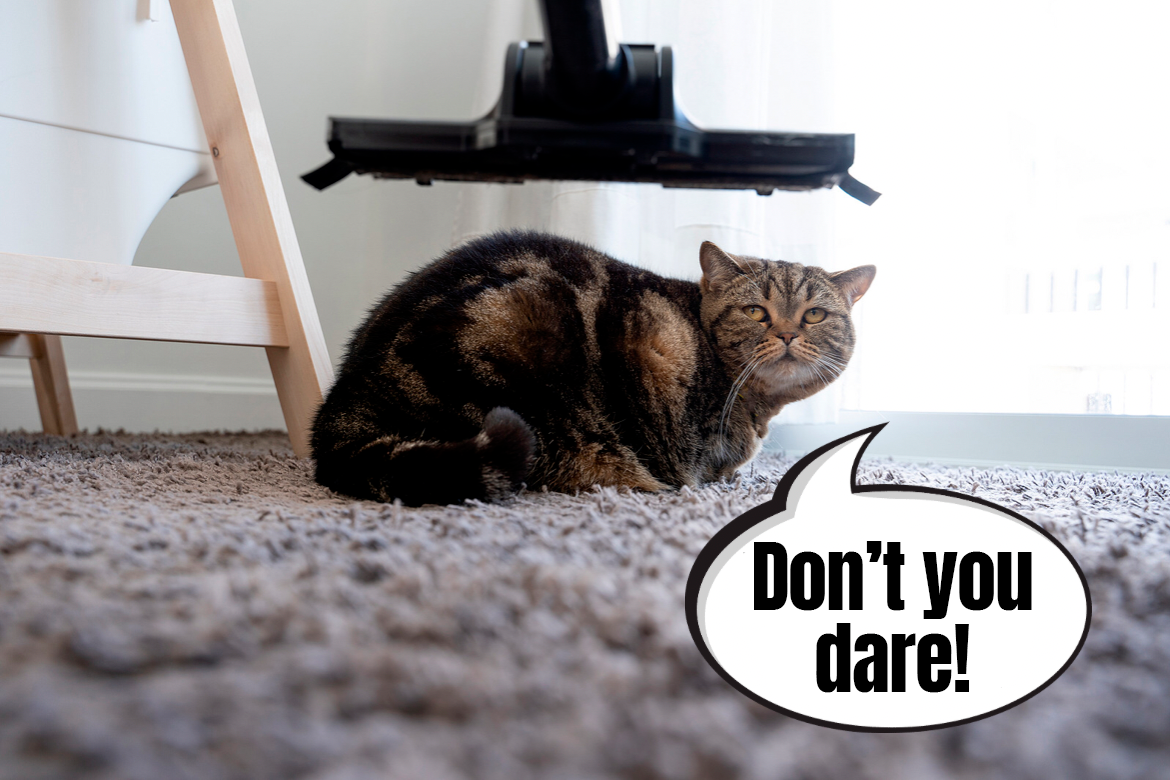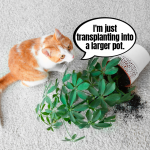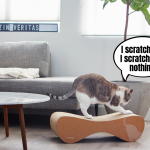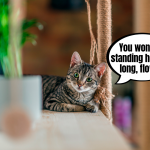Cat hair anywhere and everywhere? For an experienced cat caregiver it’s never a problem. After all, every kitty has shed some fur to get their input into their hoomans’ house decorating efforts! We do know, however, that sometimes we have to remove the fluff from the couch and the floor before the guests come in and find some in their bowl of soup or coffee. How to do it quickly and effectively? Is a house with no cat hair still a cat house? No worries, our dear fabCats – to kick the year off on a good note, we’ll try to answer some of your most important, cat hair covered questions. Curious? Let’s start.
Why cats shed?
All cats shed – losing some hair is a natural process that allows felines (and other animals) to adjust their coats to changing seasons and weather, making sure it protects them from the heat and the cold. House cats are a particular exception of that rule – as the climate in our houses is quite constant throughout the year, cats can shed all year long – they may lose more or less fur depending on the weather outside, but all in all, you’ll probably find some cat hair on your furniture, your clothes or your breakfast cereal. Oops!
If you feel like the amount of cat hair your pet is losing is normal (e.g. you’re not pulling it out by a handful each time you run your hand through their fur and your cat doesn’t seem to be balding), finding some fur on your furniture or clothes shouldn’t be a surprise, nor a huge problem. However, there might be a point when you start to think if your kitty is healthy. If there’s any doubt, consult it with your trusted vet. Why?
Your kitty’s skin and coat condition depends largely on their diet. If they’re shedding more than usual, it may be a sign of some vitamin and minerals deficiencies, different kinds of illnesses or dermatological issues. The cause doesn’t always have to be serious for the overall health of your cat, but if you’re worried about the symptoms (excessive shedding), take a look into your kitty’s bowl and consult with a cat dietitian as well as a vet. Doing a basic health check-up with blood and poop tests, fitting the diet to the needs of your cat and consulting a pet dermatologist can make a big difference and help you minimise the amount of cat hair flying loosely around the house.
You can find out more on why cats shed in our previous article:
Long coat, less problems – why it’s easier to clean up after long-hair cats
It might feel like those with long-haired cats will have more troubles with fur flying around their house. After all, it’s the fluffier kitties who need a regular brushing out (at least 1-2 times a week). In reality, although long hair is more visible, the problem of loose fur is much more difficult to deal with where short-haired cats (and dogs) live. The issue seems to be mostly the soft and fluffy undercoat that is responsible for thermoregulating cats’ bodies and serves as a scaffolding for the guard coat. If the cat is short-haired, the fluffy undercoat can get loose more easily plus it often gets deep into different material of your furniture or clothes, being harder to remove than long hair that stays on the surface. The outer layer of fur in short-haired cats is often more stubby and coarse, which makes it more difficult to remove from different surfaces.
Do you remember some of the most furtastic cat breeds? We’re wondering how their caregivers are managing the amounts of cat hair left on their couches!
How to deal with cat hair? Start with grooming
Before you go on a crazy mission of removing all cat hair from your furniture, clothes and rugs, it’s worth focusing on taking proper care of the fur that is still on your cat’s back. If you remember to regularly brush out most of the dead hair that the kitty is naturally losing, you won’t see as much hair on every couch and chair your cat occupies. The earlier you get the cat used to a brush and a comb, the better – if it’s a purebred cat, the breeder should take care of teaching all the kitties that pampering sessions are ok and a brush-out is always welcome. You should also remember that taking care of the loose hair before and brushing out your cat is important for their health as it limits the amount of fur they swallow while self-cleaning. It reduces the risk of fur balls in their stomach, which can be dangerous if your kitty is not able to vomit them out.
A slightly harder task lays ahead of everyone who’s taking care of a long-haired cat. Beside softly brushing out their outer coat with a paddle brush, you need to remember that the hair is much longer – you need a comb to get to the bottom of it, combing through the entire length of the hair. Unfortunately, there are many caregivers who focus on brushing out their cats on the surface and only later find out that underneath the seemingly groomed coat are entire lumps of hair and matts. Those that get closest to the skin are painful, can cause irritation and bruising, but the worst thing is – it’s not that easy to remove them without causing more pain. To ease the pain and be humanitarian about it, you may need to get to a professional groomer and shave your cat and allow the fur to grow out slowly, remembering to take care of it regularly and never allowing the hair to get matted again.
Remember: just because your cat is losing fur doesn’t mean you can (or should) shave them: cats need their fur to serve as a protective layer. Shaving or artfully cutting your kitty’s hair to get a cute hairstyle is a hard no-no and can actually become a reason for a cat’s health and behavioural problems. In order to truly help your kitty with a natural process of shedding (and to avoid hairballs in their stomach), make regular brushing your ritual and routine. You should also look into some foods that can help condition your cat’s hair – giving them a raw egg yolk once a week can be really beneficial for the coat.
How not to get snowed in by the fluff?
Hoovering regularly is a must if you live with cats. More and more people decide on getting a hoover robot (like Roomba), which can take care of the fluffs on your floor while you work or relax, but they’re not miracle workers. Remember that most cat hair settles on your furniture and clothes as well as cat beds – anywhere, where your kitty spends most of the day. If you’re still using a regular hoover, find an attachment designed for picking up animal hair, as it’ll make it easier to clean your furniture or rugs. Some of our fabCats lower the suction power (just to be safe and gentle) and use the special attachment to clean their myKotty scratchers!
To pick up the loose cat hair from furniture and clothes you can use the classic lint roller, but in the long run it’s neither practical nor particularly eco-friendly. A great alternative would be a brush with silicone hair designed for getting hair off of furniture (you can find some on Zooplus) or a self-cleaning brush for upholstery. Microfibre used as the surface of the brush has a special structure that can pick up hair when you go one way, but is completely smooth if you go the other way – it’s not destroying your furniture and allows you to clean different surfaces in multiple directions, without having to awkwardly hold the handle of the brush. Once there’s enough hair on the brush itself, you just put it in the container that it comes with and as the microfibre panels inside go in the opposite direction to the ones on the brush, it cleans itself – the only thing you need to worry about is emptying the container out once in a while. Easy, affordable and eco-friendly! You can find a brush like this in many online stores – just type in “Pet Hair Remover Static Brush” in your browser.
Final fluffs
If you don’t want to get snowed in by cat hair, giving your pets access to many cat beds, pillows and blankets can help you a lot! Our kitties leave most of their loose fur in places they spend most of their time sleeping. If they have the choice between your chair (which they have to leave anyways when you’re working) or a big, soft and cosy EMI pillow, an off-the-ground OTI bed or a soft and compact PADI pillow, they’ll definitely choose the second option. A cat bed can also be easily cleaned up with a brush, a hoover or even a slightly damp hand.
Where there’s a cat, there’s cat hair. For a true fabCat it’s not really an issue, but an amazing award from the kitty – we might try hard to get rid of cat hair off of our clothes just to look presentable among other people, but a single cat hair found on the sleeve of our jumper will always warm our hearts. And how is it for you, our dearest fabCats? Are you always fighting each and every sign of cat hair in your house, or have you already accepted your fate of being surrounded with tiny fluff flying around the house 24/7? If you know any great tricks to quickly remove cat hair, please let us know – we’ll be waiting for your creativity in the comments section.




